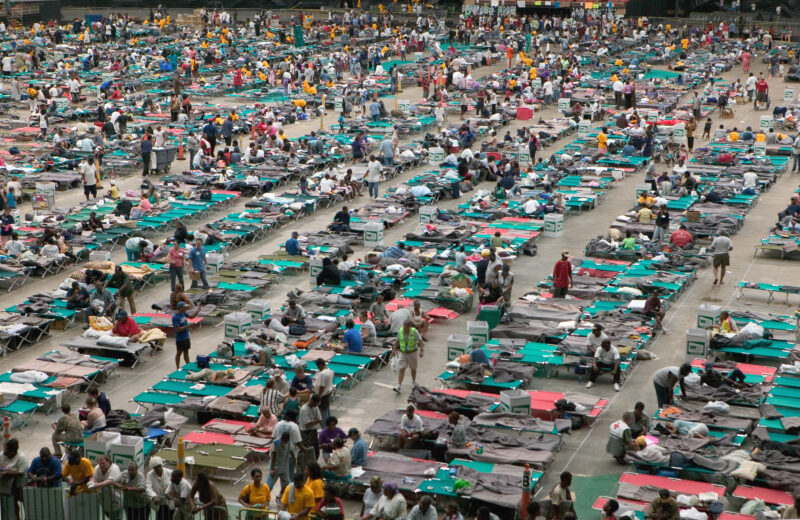Policymakers and think-tanks typically understand disaster recovery in terms of physical reconstruction of the cityscape, yet on the ground, the process of recovery is often as political as it is architectural. Siri Colom, a PhD Candidate in UC Berkeley’s Department of Sociology, is currently writing her dissertation about the social and political aspects of rebuilding post-catastrophic cities. She spent months conducting ethnographic research in New Orleans, examining how city officials, NGOs, and residents hatched plans to rebuild the city after Hurricane Katrina. We interviewed Ms. Colom about her findings and some of the key lessons urbanites might glean from the 2005 New Orleans catastrophe.
Lee: You argue that post-catastrophic reconstruction must be understood from a political perspective. How did the political landscape of New Orleans shape the rebuilding process following Hurricane Katrina?
Colom: There was always a broad consensus to rebuild New Orleans differently after the storm, but what that future city should look like depended on one’s politics. Two visions of the future city dominated most conversations about the recovery. The first addressed and remedied past racial and class divisions that had caused so much inequity among the storm’s victims in the first place.
The second vision treated inequality differently. Championed by some political leaders and members of the real estate and tourism industry, this plan identified the city’s problem as the poor themselves, not the structural origins of poverty. In my mind, this political coalition hoped to rebuild a city free of marginalized residents. In the end, their vision triumphed, though not without contestation.
Lee: How did rebuilding after a natural disaster mirror other urban renewal projects?
In the past, projects labeled as ‘urban renewal’ often shuffled a marginalized group from one site to other areas of the city. Similarly, in post-Katrina New Orleans, multiple decisions proved hostile to poor and working class citizens, primarily African Americans. One of the most dramatic examples was the decision to close low-income public housing and replace it with mixed-income housing. Another example was the decision to shutter the only public hospital serving low-income residents. I also found that federal recovery dollars supported property owners over renters, and high-income property owners over those living in low-income communities. Recovery funds were distributed as unevenly as the original path of destruction.
In the last two decades, many poor communities have been pushed from urban areas throughout the world. In New Orleans, the disaster simply accelerated this process.
The recovery process sidelined any serious responses to the structural causes of poverty. Yet the issue of poverty was central to the severity of the disaster.
Lee: Katrina quickly came to be regarded as a national disaster. The process of rebuilding garnered far less national attention. Why?
Colom: Katrina was one of the most watched media events in the past few decades in the U.S. It came at a time when the development of new social media had begun to find its footing. For a moment, the media attention opened up a dialogue around structural inequality and the lasting effects of living in a racially divided city. Practically every social science journal had a special edition on Katrina. But interest in the academic world was as fleeting as that of the media, and most studies were conducted from a national or international vantage point.
At the same time, the city became a magnet for celebrities, volunteers, and funders looking to make a contribution. Their voices soon dominated coverage of the city and rebuilding efforts. As a result, local political struggles receded from the national imagination.
My task was to understand the political struggles unleashed by the flood. In post-Katrina New Orleans, we see trends common to other cities: the privatization of public goods, shrinking political participation, the displacement of poor and working class residents, and the dismantling of regulation in the name of small government. I saw residents actively resisting these changes, and mobilizing what few resources they had to gain acknowledgment from the local state. My dissertation addresses much more than the physical rebuilding of a city. It is dealing with issues of political belonging and the consequences of exclusion in the modern city.
Lee: What advice would you have for policymakers or urbanites confronting the possibility of extreme weather in their own cities?
Colom: My research offers two main recommendations. In post-catastrophe areas, officials too often focus on the immediate restoration of economic infrastructure. In the case of New Orleans, officials prioritized the restoration of the oil and gas industry, tourism, the shipping port, and the real estate market. Yet the profits of these sectors were often threatened by stricter environmental policies. As a result, the process of “recovery” came at the expense of policies aggressively addressing climate change, thereby sowing the seeds of another environmental disaster. This trend must be corrected.
At the same time, the rebuilding process often displaced those most gravely affected, New Orleans’s poorest residents. As a result, the recovery process sidelined any serious responses to the structural causes of poverty. Yet the issue of poverty was central to the severity of the disaster. To address such a potentially catastrophic problem as climate change, we must engage the broadest spectrum of coalitions and interests.
Photo Credit: Andrea Booher/FEMA


